Function Point Analysis (FPA)
Consistent and Stable Software Size
What are Function Points?
Meaningful Metrics: Developed in the late 1970s by Allan Albrecht as a means of measuring software size in terms that are meaningful to end users, function points have become an international standard used to measure software size (ISO 20926:2009).

How They Work
- Function points are a logical size measure (as opposed to a physical size measure like lines of code or objects).
- Function points measure software size based on the functionality requested by and provided to the end user.
- Function points are derived from requirements and are applicable for measurement throughout the entire development life cycle.
- Function points are comprised of inputs, outputs, inquiries, internal data, and external interface data.
Example Metrics
- Effort per function point (productivity)
- Defects per function point (quality)
- Cost per function point (cost efficiency)
Advantages
- Technology, platform, language independent
- Excellent as a basis of estimate for development cost and schedule
- Provides ability to normalize metrics for consistent analysis
- Fully documentable and repeatable
- Assists with requirements management; functional size traceable throughout entire life cycle
- Provides quantitative basis for earned value management

Become a Certified Function Point Specialist (CFPS)
As the use of IFPUG Sizing Standards continues to grow, it is essential that individuals with a specialized level of knowledge be distinguished. The IFPUG Certification Program designations are formal recognition of a level of expertise in the area of either Functional Sizing or Non-Functional Sizing.
Download the Latest Function Point Counting Practices Manual (CPM) Release
The CPM’s primary objectives are:
- Comply with ISO/IEC 14143-1:2007
- Provide a clear and detailed description of function point counting
- Ensure that counts are consistent with the counting practices of IFPUG affiliate members
- Provide guidance to allow function point counting from the deliverables of popular methodologies and techniques
- Provide a common understanding to allow tool vendors to provide automated support for function point counting
Available in English, Italian, Portuguese, Spanish, French, Chinese, Japanese, and Korean
iTIPS, uTips and vTips
iTips provide guidance on topics important to the IFPUG Sizing Standards (FPA & SNAP) community. An iTip is intended to be a short document (only a few pages), explaining the application of IFPUG Sizing Standards methods in a common situation. An iTip is an example of a single application, not an exhaustive examination of a particular subject. iTips are not rules, but interpretation of the rules, and provide guidance using a realistic example to explain a particular topic.
uTips (Usage Tips) provide insight into potential uses of function points/SNAP points to support an organization’s business needs. While uTips provide insight on usage opportunities, they do not provide detailed direction on the application of the IFPUG Sizing Standards methods in a particular situation. When necessary, the uTip maybe be followed by additional content on the topic providing specific how-to guidance. uTips are not rules, but rather interpretation and application of the rules, and provide guidance using a realistic example to explain the topic being covered.
vTips (Video Tips) are iTips and uTips delivered in a video medium.
IFPUG offers iTips, uTips, and vTips at no charge to the international function point community to stimulate the further use and consistent application of the IFPUG Sizing Standards Methods.
If you have a suggested topic related to FPA for an iTip , uTip, or vTip, please send it to [email protected].
- iTip #08 – Integrated Queries
- iTip #07 – Derived Data in Classifying an EO
- iTip #06 – Shared Data Real-Time Responses
- iTip #05 – Real-time Data Sharing
- iTip #04 – Data Conversion
- iTip #03 – Logon (updated 2018)
- iTip #02 – Charts and Graphs
- iTip #01 – Help!
SNAP iTips can be found on the SNAP Standards page.
If you have a suggested topic related to SNAP for an iTip or a uTip, please send it to [email protected].

